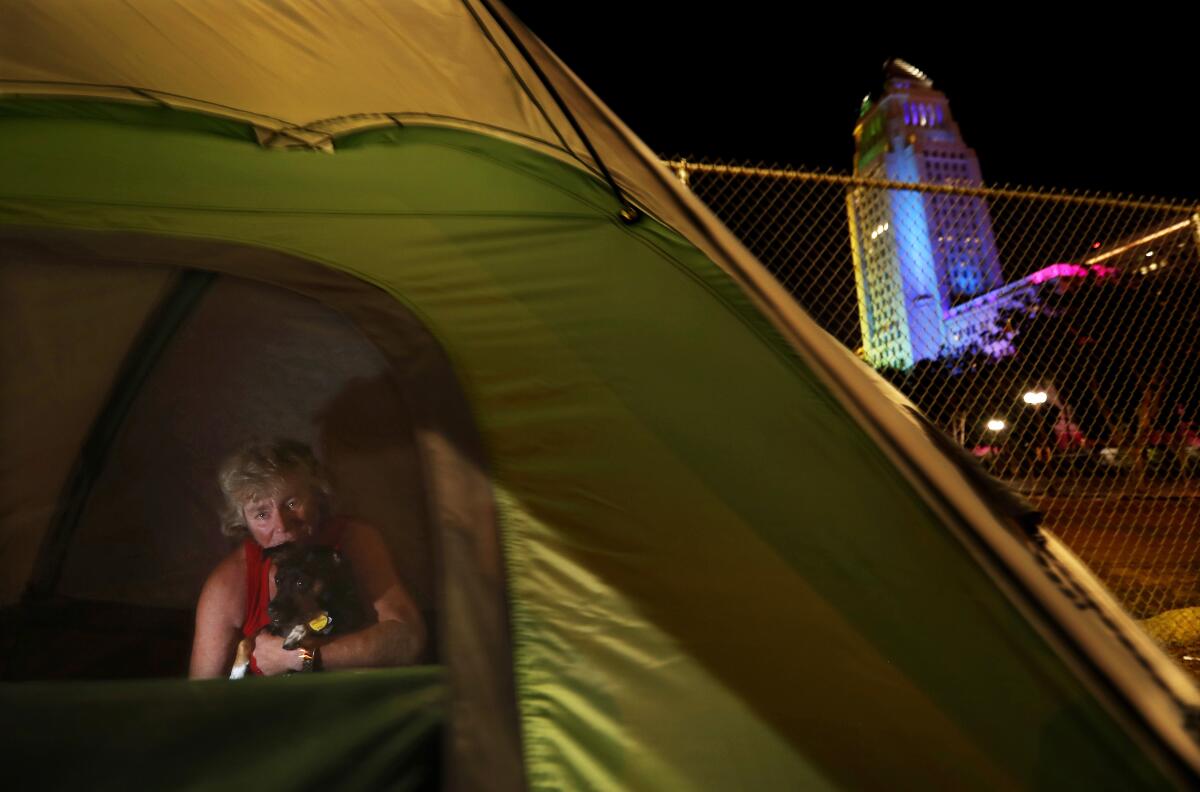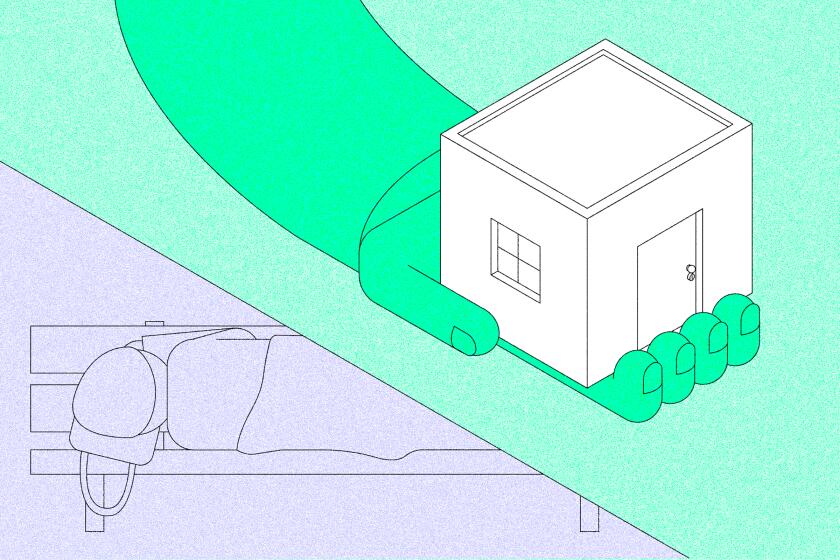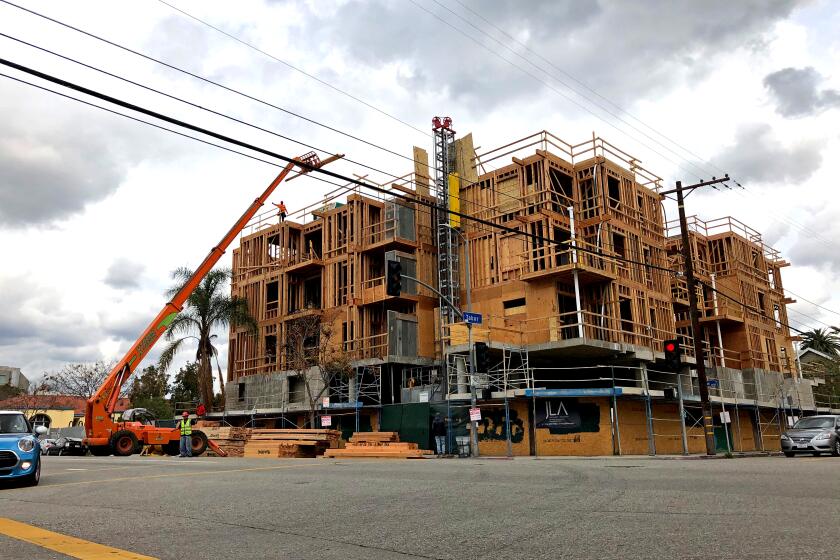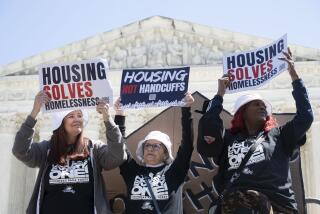Editorial: Six ways for a new mayor to tackle homelessness without kicking someone off the street first

Homelessness has been one of the most fraught issues that the city and its elected leaders have faced in the last decade.
Mayor Eric Garcetti, who is expected to leave office soon to become President Biden’s ambassador to India, gets blamed for not having reduced the size of the homeless population. But to his credit, Garcetti helped convince residents to vote for Proposition HHH, the $1.2-billion bond measure that will build as many as 10,000 units of permanent supportive housing, and created A Bridge Home, the shelter program that has built more than 2,000 beds of temporary group housing. Yes, HHH construction has gone slowly; only about 1,200 units are open more than five years since the measure passed in 2016. And none of this effort has stemmed the flow of people into homelessness.
Los Angeles voters will choose a new mayor this year, and poll after poll shows that homelessness will be the top issue in the campaign.
We know what all the candidates are going to say: No one should be living on a sidewalk. Homelessness is a public health crisis. It needs to be treated like an emergency.
It may not be easy to set up, but a right to housing should be essential in Los Angeles.
Agreed. But those are sound bites. Let’s move on to the harder part — getting homeless people housed and preventing housed people from becoming homeless.
Here are some things we would like to see from mayoral candidates when they are out there talking about homelessness:
Don’t say the root cause of homelessness is mental illness and substance abuse.
Yes, both of those problems bedevil some people on the street, and they can be contributing factors to an individual becoming homeless or staying homeless. According to the 2020 demographic survey of homeless people conducted by the Los Angeles Homeless Services Authority, 25% reported that they suffered from a mental illness and 27% reported that they had a substance use problem. About 41% had one or the other or both in 2020, according to the authority’s analysis.
But the most pressing problem for all homeless people is a lack of housing. Over the last two decades, the city has lost much of its cheap housing — such as single-room occupancy hotels —the kind people could afford even if they were poor and suffering from a mental illness or substance abuse disorder.
There are people who need treatment for mental health or substance abuse problems at a residential clinical center. But service providers say that for most homeless people dealing with those issues, providing them a home first gives them a stable base from which they can get treatment. L.A. Homeless Services Authority officials say that about 90% of people who go into permanent supportive housing in L.A. County are still housed a year later. The National Alliance to End Homelessness puts the retention rate at 98%. The philosophy of Housing First doesn’t mean Housing Only. It means get someone housed and then offer them treatment options.
Talk about how you’re going to increase the housing supply in the city.
We need housing at all price levels — including market rate. But we particularly need to increase the availability of affordable housing if we want to keep people from falling into homelessness. The city’s new Housing Element 2021-2029 requires the city to make room for more than 450,000 units of housing by 2029. Nearly 185,000 of those should be affordable to low-income and very low-income households. The candidates should offer concrete plans for how they would come up with the public funding and government incentives to get more affordable housing built.
Los Angeles has created an ambitious plan to build more housing, especially affordable housing, throughout the city.
Talk about how you’ll protect vulnerable renters and others from losing their housing.
For the record:
1:08 p.m. Feb. 22, 2022An earlier version of this editorial said the L.A. Homeless Services Authority placed 20,690 people into permanent housing in 2021. That was done in 2020.
On average, in Los Angeles County, 227 people become homeless each day, while an additional 207 people get out of homelessness, either on their own or through a housing placement or rental subsidy. The Homeless Services Authority says it placed 20,690 people into permanent housing in 2020. But the county and the city haven’t been able to lessen, let alone stop, the inflow of people into homelessness. Among the people in the city who do have housing, most are renters and 50% of those spend more than half their income on rent and utilities, leaving them with little savings to handle a rent increase, a job loss or an unexpected bill. The candidates should lay out their plans to protect renters and help people stay in their housing.
Acknowledge that the city needs more permanent housing than shelter beds.
The city cannot shelter-bed its way out of homelessness. Temporary housing is expensive and, ultimately, a homeless person in a shelter is still a homeless person. The county needs five permanent housing placements for every shelter bed, according to the Homeless Services Authority. Right now, the ratio is 1 to 1. That means the people who are in shelters are stuck there because they can’t be moved into permanent homes — leaving no room for people on the street who want a shelter bed. Yes, there is a need for some temporary housing for the thousands of people sleeping on the streets. But the bigger effort should be aimed at finding faster ways to create affordable and permanent supportive housing faster. Toward that end, the candidates should explain how they would accelerate and expand existing efforts to buy or lease hotels, motels and apartment buildings.
Don’t pander to voters by talking only about enforcement efforts.
It’s easy to talk tough about enforcing anti-camping ordinances. But any person shooed off one sidewalk will turn up on another sidewalk. The Los Angeles Police Department neither can nor wants to police every sidewalk — or even the sidewalks made off-limits under an anti-camping ordinance. When residents complain about encampments in their neighborhoods, the candidates should be honest about what it will take to get homeless people off the sidewalks: more housing, both permanent and temporary, in every community in the city, including theirs.
Put a stop to the fragmented approach to homeless housing.
Garcetti hasn’t been able to carry out a citywide strategy to end homelessness, so the 15-member City Council has been setting homelessness policy district by district, offering temporary housing only for homeless people who can be identified as having lived in the district for a certain amount of time. Even available services can differ “depending on what neighborhood, block, or even the side of the street you live on,” tweeted an exasperated Councilwoman Nithya Raman. “This system is totally absurd.” Homelessness is a citywide problem. The candidates need to explain how they will be aggressive — or persuasive — enough to finally address homelessness on a citywide basis.
More to Read
A cure for the common opinion
Get thought-provoking perspectives with our weekly newsletter.
You may occasionally receive promotional content from the Los Angeles Times.












